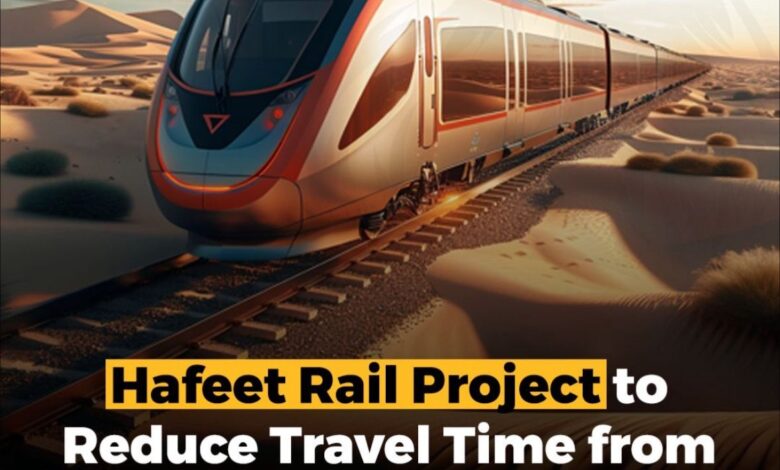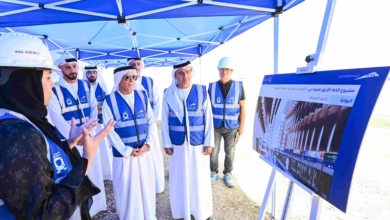
A New Track for Progress: Hafeet Rail and the Dawn of the UAE-Oman Railway Era
The Hafeet Rail project marks a monumental stride in enhancing railway connectivity between the United Arab Emirates and Oman, thanks to the collaborative efforts of Etihad Rail, Oman Rail, and Mubadala Investment Company. At a budget of $3 billion, this rail project not only promises to revolutionize train travel in the region but also aims to foster economic growth by providing a quicker mode of transport for travelers moving between the UAE and Oman.
With Hafeet Rail entering its implementation phase as of April 24, 2024, the venture is setting a precedent for railway projects in the Middle East, embodying the connection between the two nations while paying homage to the significant Jebel Hafeet Mountain. This initiative is poised to significantly impact trade, enhance travel to Oman from UAE, and further regional integration, making it a pivotal moment for both countries’ development and connectivity.
Key Agreements and Partnerships
Overview of Agreements and Partnerships
The Hafeet Rail project, a pivotal development in the railway sector between the UAE and Oman, has been propelled by a series of strategic agreements and partnerships. These collaborations have set the foundation for a robust infrastructure that promises enhanced connectivity and economic synergy between the two nations.
Strategic Financial and Construction Partnerships
- Public-Private Financing Model: The project’s funding model is a balanced public-private partnership, with 60% of the finance sourced from private investors and 40% contributed by the government. This model underscores the project’s strategic importance and the confidence in its successful implementation.
- Construction and Civil Works Alliances:
- A significant contract for civil works and construction was secured by an Omani-Emirati alliance, featuring prominent companies such as Trojan Construction Group and Galfar Engineering and Contracting.
- Systems and integration responsibilities have been awarded to a joint venture between Siemens and Hassan Allam Construction (HAC), focusing on advanced railway technologies including a desert-proof European Train Control System (ETCS Level 2).
Enhancing Bilateral Relations Through Shared Ventures
- Joint Network Establishment:
- The UAE and Oman have formalized their commitment to construct the Hafeet Rail network, which is seen as a significant step in strengthening their historical ties and promoting economic integration.
- This agreement was further emphasized during the state visit of His Majesty Sultan Haitham bin Tarik to the UAE, where multi-sectoral deals worth billions were signed, showcasing the depth of collaboration.
- Industrial and Technological Advancements:
- The agreements include ambitious projects such as a Dhs117bn industrial and energy “megaproject” focusing on renewable energy and green metals production.
- Additionally, the establishment of the $180m technology focused Jasoor Fund between Abu Dhabi wealth fund ADQ and Oman Investment Authority highlights the forward-thinking approach of both nations towards technological innovation.
Table: Summary of Key Agreements and Partnerships
| Partnership Aspect | Entities Involved | Focus Area |
| Financial Model | Public-private sectors | Funding and Investment |
| Construction and Civil Works | Trojan Construction Group, Galfar Engineering | Infrastructure Development |
| Systems and Integration | Siemens Mobility, Hassan Allam Construction (HAC) | Technological Advancements |
| Bilateral Agreements | UAE and Oman governments, Etihad Rail, Oman Rail | Economic and Commercial Integration |
| Industrial and Technological Projects | ADQ, Oman Investment Authority | Renewable Energy, Technology Fund |
This strategic framework not only underscores the multifaceted nature of the Hafeet Rail project but also highlights the collaborative spirit driving this significant venture.
Impact on Trade and Economy
Economic Growth and Job Creation
The Hafeet Rail project is set to be a catalyst for substantial economic development in both the UAE and Oman. By improving supply chain efficiencies and reducing transportation costs, the rail network is anticipated to boost the GDP of the regions it serves by approximately 1.5-2%. This economic uplift is expected to create over 10,000 direct and indirect jobs during the construction phase, with around 3,000 permanent positions available once the project is operational.
Enhancing Industrial and Commercial Opportunities
The rail network will significantly enhance various industrial sectors such as mining, iron and steel, agriculture, food, retail, e-commerce, and the petrochemical sector. This enhancement will provide increased commercial and investment opportunities for the private sector, attracting both national and foreign investments. Additionally, the project will support the integration of Omani port activities with regional and international markets, further driving economic growth.
Tourism and Social Benefits
The Hafeet Rail project is also expected to stimulate tourism activities between Oman and the UAE. By providing a convenient and comfortable travel option, the rail network will likely see a surge in tourists exploring both countries. This increase in tourism will not only strengthen the competitiveness of both nations in global trade but also foster social and familial cohesion, enhancing the quality of life for residents and visitors alike.
Table: Key Economic Impacts of Hafeet Rail
| Impact Area | Description |
| GDP Contribution | Estimated increase of 1.5-2% to regional GDP |
| Job Creation | Over 10,000 jobs during construction, 3,000 permanent jobs |
| Industrial Growth | Boost in sectors like mining, agriculture, and e-commerce |
| Tourism Boost | Increase in tourist activities and social benefits |
| Cost Reduction in Transport | 10-15% reduction in transportation costs |
This strategic development not only promises significant economic and social benefits but also positions the UAE and Oman as formidable players in the global logistics and trade arena.
Technical and Operational Features
Advanced Control and Safety Systems
The Hafeet Rail network is equipped with the European Train Control System (ETCS) Level 2, ensuring high levels of safety and efficiency. This system enables complete digital train control and tracking through GPS technology, enhancing operational reliability.
Speed and Efficiency
- Passenger Trains: Capable of reaching speeds up to 200 km/h, these trains reduce the travel time from Sohar to Abu Dhabi to approximately 100 minutes and from Sohar to Al Ain to just 47 minutes.
- Freight Trains: These trains have a substantial cargo capacity, capable of transporting up to 15,000 tonnes of goods or about 270 standard containers, covering the distance between Sohar and Abu Dhabi in roughly 120 minutes.
Environmental Sustainability
The network’s operation emphasizes environmental sustainability, significantly reducing carbon emissions by replacing the equivalent of 300 trucks per train journey. This shift is expected to cut down 80% of the carbon emissions typically generated by road transport.
Operational Capacity
| Train Type | Speed (km/h) | Capacity | Journey Time (Sohar to Abu Dhabi) |
| Passenger Train | 200 | Up to 400 passengers | 100 minutes |
| Freight Train | Up to 200 | 15,000 tonnes/270 containers | 120 minutes |
This structured approach not only ensures fast and efficient transport but also supports the broader goals of economic growth and sustainability between the UAE and Oman.
Future Prospects and Regional Integration
Expanding Economic and Industrial Cooperation
The Hafeet Rail project is poised to act as a catalyst for broader economic and industrial cooperation between the UAE and Oman. By enhancing connectivity, the rail network will facilitate easier and more efficient trade and industrial activities, potentially leading to joint ventures and collaborations in various sectors.
Social and Familial Cohesion Through Connectivity
The introduction of passenger rail services is expected to forge stronger social and familial ties by providing a reliable and comfortable means of travel. This connectivity supports not only daily commuting but also cultural and social exchanges, thereby enriching the communal bonds between the two nations.
Tourism Enhancement
With the rail network offering a convenient travel option, tourism between the UAE and Oman is anticipated to experience a significant boost. The ease of travel will encourage more tourists to explore the diverse cultural, historical, and natural attractions across both countries.
Table: Prospects of Hafeet Rail in Regional Integration
| Aspect | Impact |
| Economic Cooperation | Facilitates trade and joint ventures in various sectors |
| Social and Familial Ties | Enhances connectivity and cultural exchanges |
| Tourism Growth | Increases accessibility and tourist flow between nations |
These developments are part of a strategic vision to integrate the regions more closely, not only through infrastructure but also through shared economic growth and cultural exchanges. The Hafeet Rail is a cornerstone in this vision, paving the way for a more unified future.





